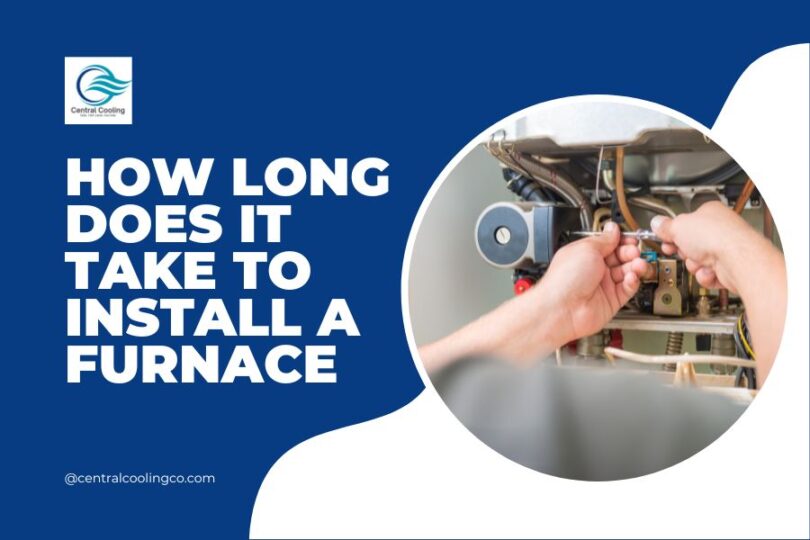Introduction:
Installing a furnace is an important and necessary process for many homeowners. Whether replacing an old furnace or installing a new one, it is essential to understand the time it takes to complete the installation. While the exact duration may vary depending on various factors, this article will provide a general overview of the installation process and the time it typically takes.
Factors Affecting Installation Time Of Furnace
Several factors can influence the duration of a furnace installation. It is important to consider these factors when estimating the time required for your specific installation:
- Type of Furnace: The type of furnace being installed can impact the installation time. Different furnaces, like gas, electric, or oil, may have varying installation requirements and complexities.
- Size and Complexity: The size and complexity of the furnace system can also affect the installation time. Larger or more complex systems may take longer to install than smaller, straightforward ones.
- Location: The location of the furnace installation can affect the overall time required. Additional time may be needed if the installation involves accessing tight or hard-to-reach spaces.
- Existing Ductwork: If there is existing ductwork, the installation time may be reduced as it can be utilized for the new furnace. However, if modifications or repairs are necessary, it may increase the overall installation time.
- Permits and Inspections: Depending on local regulations, obtaining permits and scheduling inspections may add time to the installation process.
Preparation Of The Furnace:
Before the actual installation of the furnace can begin, several important preparation steps need to be completed. These steps ensure the installation process goes smoothly and the furnace is installed correctly.
Sizing And Selection:
The first step in preparing for a furnace installation is to determine the correct size and type of furnace for your home. This involves considering factors such as the size of your home, insulation, and climate. It is recommended to consult with a professional HVAC contractor who can accurately calculate the heating load requirements for your specific needs.
Removing The Old Furnace:
If you are replacing an existing furnace, the old unit must be removed before the new one can be installed. This process typically involves shutting off the power, disconnecting the gas or oil lines, and removing the old furnace from its location. The time required for this step will depend on the complexity of the existing setup and any additional repairs or modifications that may be necessary.
Preparing The Installation Area:
The installation area must be prepared once the old furnace has been removed. This includes cleaning the area, ensuring proper ventilation, and making necessary modifications to accommodate the new furnace. The time required for this step will vary depending on the installation area’s condition and the new furnace’s specific requirements.
Installation Of The Furnace:
Once the preparation steps have been completed, the actual installation of the furnace can begin. This stage involves connecting the new furnace to the existing ductwork, electrical system, and fuel source. The time required for the installation will depend on various factors, including the complexity of the system, the accessibility of the installation area, and the experience of the HVAC contractor.
Ductwork Connection:
The first step in the installation process is connecting the new furnace to the existing ductwork. This involves carefully aligning and sealing the ducts to ensure proper airflow throughout the home. The time required for this step will depend on the complexity of the ductwork system and any necessary modifications or repairs.
Electrical Connection:
Next, the new furnace needs to be connected to the electrical system. This includes wiring the furnace to the circuit breaker and ensuring that all electrical connections are secure and in compliance with local building codes. The time required for this step will depend on the complexity of the electrical system and any necessary modifications or upgrades.
Fuel Source Connection:
If your furnace runs on gas or oil, it must be connected to the appropriate fuel source. This involves connecting the gas or oil lines to the furnace and ensuring all connections are secure and leak-free. The time required for this step will depend on the type of fuel source and any necessary modifications or upgrades.
Testing and Inspection:
Once the installation is complete, the furnace must be tested and inspected to ensure it functions properly and meets all safety and efficiency standards. This includes checking for proper airflow, verifying the ignition and combustion processes, and testing the thermostat and controls. The time required for this step will depend on the complexity of the system and any necessary adjustments or repairs.
Testing And Troubleshooting Of Furnace Installation:
Once the furnace installation is complete, thorough testing and troubleshooting are crucial to ensure its proper functioning. This step helps identify any potential issues and allows for necessary adjustments or repairs. Here are some key aspects of testing and troubleshooting:
- Start-up and initial testing: The HVAC technician will initiate the furnace and check if it starts up correctly. They will also verify if all the components, such as the blower motor, igniter, and gas valve, function as intended.
- Performance testing: The technician will assess the furnace’s performance by measuring its airflow, temperature rise, and combustion efficiency. This step helps ensure that the furnace operates optimally and provides sufficient heat to your home.
- System integration: If you have additional components like a thermostat or air purification system, the technician will integrate them with the furnace and test their functionality.
- Final adjustments and documentation: The technician will make necessary adjustments to optimize the furnace’s performance. They will also provide documentation, including warranty information and maintenance recommendations.
- Carbon monoxide testing: Carbon monoxide testing is crucial for ensuring safety during furnace installation. The technician will conduct tests to detect and prevent furnace carbon monoxide leaks, ensuring proper venting and a secure environment
Permits And Regulations For A Furnace Installation:
Obtaining the necessary permits for a furnace installation is crucial to ensuring compliance with local building codes and safety standards. The specific permits required may vary depending on your location, so it’s important to check with your local building department or HVAC contractor for the exact requirements.
Here are some common permits and regulations associated with furnace installations:
- Building Permit: A building permit is typically required for any major HVAC installation. It ensures that the installation meets local building codes and safety standards.
- Electrical Permit: An electrical permit may be required if any electrical work is involved in the installation, such as wiring or connecting the furnace to the electrical system.
- Gas Permit: A gas permit may be necessary to ensure proper installation and safety if your furnace operates on natural gas.
- Inspection: After the installation, a final inspection may be required to ensure the furnace meets all safety and efficiency standards.
It’s important to note that failing to obtain the necessary permits can result in fines, penalties, and potential safety hazards. Hiring a licensed HVAC contractor will help ensure all permits and regulations are properly handled.
Typical Installation Time Of Furnace:
A furnace installation can take anywhere from half a day to several days to complete. However, it is important to note that this is just a general estimate, and the time required can vary.
The installation can typically be completed within a day to replace an existing furnace of the same type and size. This assumes that there are no additional complications or repairs needed.
In cases where a new furnace is installed or significant modifications are required, the installation may take longer. Depending on the project’s complexity, this can range from two to three days or even more.
Additional Considerations:
While the installation time is an important factor to consider, it is equally crucial to prioritize the quality of the installation. Hiring an experienced and licensed HVAC contractor ensures that the installation is done correctly and meets all safety standards.
Additionally, it is advisable to schedule the installation when you can be present to address any questions or concerns. This will help ensure a smooth and efficient installation process.
Frequently Asked Questions:
Is It Possible To Install A Furnace In One Day?
In most cases, yes. A professional HVAC technician can typically complete a furnace installation in a single day. However, more complex installations or unforeseen complications may require additional time.
How Long Does It Take To Remove An Old Furnace?
The time required to remove an old furnace can vary depending on the condition of the unit and the accessibility of the installation area. On average, the removal process can take around 1 to 2 hours.
Can The Installation Process Be Completed During The Winter?
Yes, furnace installations can be performed during the winter. However, extreme weather conditions or other factors may affect the scheduling and completion time. It is best to consult a professional HVAC company for an accurate estimate.
Can I Use My Existing Ductwork With A New Furnace?
In many cases, existing ductwork can be used with a new furnace. However, it is important to have a professional assess the condition and compatibility of the ductwork to ensure optimal performance and efficiency.
Conclusion:
The process of installing a furnace can vary significantly depending on various factors. It is vital for homeowners to enlist the expertise of a professional contractor who can adeptly handle any unforeseen complications that may arise during the installation process. By taking into account these variables and allocating sufficient time for installation, homeowners can ensure that their new furnace is installed effectively, providing the desired comfort and efficiency for their household.
Disclosure: We may get commissions for purchases made through links in this post.








